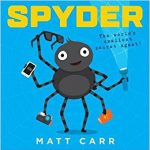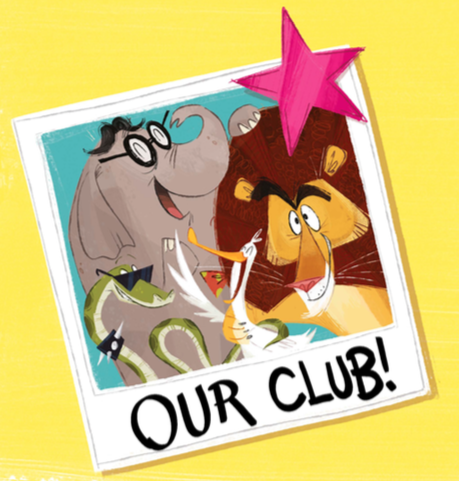Today the blog tour for Holly Webb’s latest book A Tiger Tale stops here, at Library Mice. As i, I thought it would be interesting to look into the process of illustrating fiction a little more and therefore I am delighted to welcome award-winning illustrator and firm Library Mice favourite, Catherine Rayner, for a Q & A about her experience of illustrating A Tiger Tale.
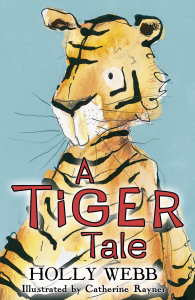 Kate’s grandfather has passed away and she is struggling to cope with the feelings overwhelming her. She seeks comfort in Amos, the beautiful toy tiger that Granddad had bought for her. And comfort he brings, but Kate does not expect Amos to turn into a real, beautiful, majestic tiger who smells and sounds like Granddad. With the help of Amos, Kate gradually begins to realized that although Granddad is gone, he still lives on, in her heart and her most cherished memories.
Kate’s grandfather has passed away and she is struggling to cope with the feelings overwhelming her. She seeks comfort in Amos, the beautiful toy tiger that Granddad had bought for her. And comfort he brings, but Kate does not expect Amos to turn into a real, beautiful, majestic tiger who smells and sounds like Granddad. With the help of Amos, Kate gradually begins to realized that although Granddad is gone, he still lives on, in her heart and her most cherished memories.
Bereavement and dealing with the heartbreak of loss is not always easy to tackle in children’s literature. In fact it is often easier to tackle in picture book form, where pictures can more easily express sorrow and the empty space left behind. However once again, with the lovely Amos this time, Holly Webb once again uses animals to help young readers make sense of such feelings. She captures Kate’s confusion with her own feelings perfectly and teamed with Catherine Rayner’s beautiful sketches, A Tiger Tale is a heartwarming story which will touch the heart of its readers.
A Q & A with Catherine Rayner
The artwork in a picture book often adds meaning to the text, while in illustrated fiction it tends to convey the text itself, as well as helping to break it up in more manageable chunks for young readers. Do you choose which scenes of the book are illustrated or is this directed by the editor? Can you tell us more about the process?
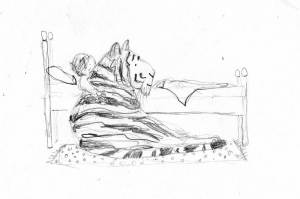
Drawing for illustrated fiction is a completely different process. Often there are very detailed written descriptions of the characters, their surroundings and their emotions so you have to make sure every illustration follows the words. I really enjoy having such tight guidelines as it’s almost the opposite of illustrating picture books – where words are usually saying something different to the pictures and each compliments the other in it’s own way.
For A Tiger Tale I was asked to do a small drawing to go at the start of each chapter and one larger illustration to go in each chapter. I was sent a synopsis of the text, along with a written brief explaining what the editor thought would work well as an illustration. I then sent rough drawings showing what I proposed to do for the final illustrations. Once these were approved by the editor, I went on to make the final artwork.
Does the difference in format impact on the way you draw? How different is it to draw illustrations for a fiction book rather than a picture book?
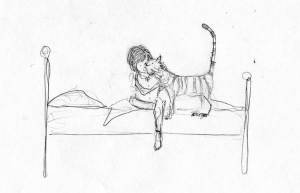
It has a huge impact on the way I draw. The text tells us what the characters are wearing, how old they are and might even say what the room looks like where the characters are sitting. There are so many little details that have to be fitted in to a relatively small illustration (the books are smaller than picture books). You also are also limited to black and white which alters the way you execute an image. I’m always more nervous illustrating another author’s texts as I don’t want to get a detail wrong.
Drawing Amos was different though. I just knew that he had to be a lovable, and much cuddled tigery teddy. I approached him as I would one of my picture book characters. He was also a full colour illustration for the cover. I have to admit, I’m a little bit in love with Amos!
You are renowned for your exceptional talent for drawing animals, and the cover of A Tiger’s Tale is witness to that. However there are a lot of drawings of people in this book, which is more unusual in your work. Do you feel more comfortable drawing animals, and is it more of a challenge to draw people?
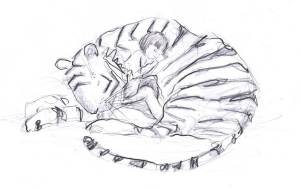
I feel very ‘at home’ when I draw creatures, it’s second nature to me. Something about them makes me feel calm. People are different, mainly because the wear clothes which brings up all kinds of challenges! I love fabrics so it’s a pleasure drawing patterns. I try to approach people just like they are two legged animals!
Amos is not the first tiger you have illustrated, as I am sure readers will recall your magnificent Augustus. But of course Amos is in fact a stuffed toy, brought to life by Lily’s imagination, very much like Hobbes from Calvin & Hobbes. How did you approach this subtlety of Amos’ identity? And what inspired you most for your drawings, a real tiger or a stuffed toy?
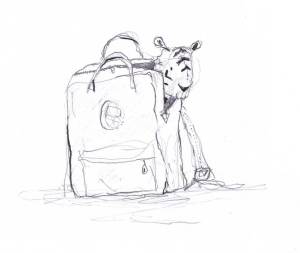
What a wonderful question. To be perfectly honest, it was Holly’s beautiful writing that inspired Amos. When I read the story I just ‘knew’ what he should look like and he appeared very easily on the page. I have spent a lot of time observing and drawing tigers so I feel comfortable drawing them from memory.
Finally, I know you have illustrated other fiction books, including one of my favourite books from childhood, Michael Bond’s Tales of Olga da Polga. But if you could choose to illustrate any classic novel for children, which one would it be, and why that one particularly?
It would be The Jungle Book! I’d love to draw the charismatic animal characters surrounded by the beautiful foliage of the jungle – it would be a dream come true!
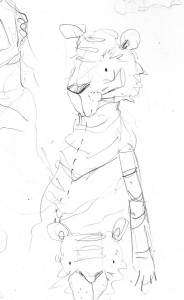
***
Thank you so much Catherine. I would love to see The Jungle Book illustrated by you, I hope there are publishers reading this!
You can buy A Tiger Tale here.
 You can follow the other blog posts from the blog tour:
You can follow the other blog posts from the blog tour:
You can discover why Holly Webb wrote A Tiger Tale on Read It Daddy
You can check out Holly Webb’s selection of books on death and bereavement on Rainy Day Mum
You can read a lovely interview with Holly Webb on Bookbabblers
And don’t forget to check out Serendipity Reviews tomorrow.



